Clutching morphine and sheltering in a bus stop: the NHS patients sent from hospital to the street
Special report: Patients with no address were discharged from maternity departments, stroke wards, general surgery, and after treatment for complications caused by HIV, freedom of information data showed
Gripping a bag of morphine handed to him by hospital staff, Antonio sheltered at a bus stop, cold and shivering, as he tried to work out what to do.
It was three days after undergoing gruelling surgery to remove his testicular cancer and the 36-year-old had been discharged from NHS care with nowhere to go.
He was clutching a referral letter for the council’s housing team, given to him by hospital staff. When he arrived at the council office, he explained he had been homeless for the past few months – but was told they could not house him.
“They asked me: ‘If you are in so much pain and trouble, why did they send you here?’ and I didn’t know what to say,” Antonio, whose name has been changed, tells The Independent. He was given a piece of paper with a phone number on it and told to call the next day.
It was now late in the afternoon and the Salvation Army’s homeless day centre, where he would usually go for help, was closed. He had no option but to turn around and ready himself for a night on the streets.
Antonio’s story is, tragically, not unique. He is one of thousands of people across England who have been discharged from NHS hospitals into homelessness in recent years, many while still battling serious health conditions.
Data obtained by The Independent, in collaboration with the Salvation Army, shows at least 4,200 people were discharged from wards to “no fixed abode” in 2022/23.
According to the figures, which came from FOI responses from around half of NHS trusts, there were another 1,461 occasions that people were discharged in this way, but the data does not reflect whether these were individual cases or repeat patients.
The shocking statistics show patients were discharged from a range of wards, including maternity departments, stroke wards and general surgery. Some had recently undergone treatment for complications caused by HIV.
These patients may end up in B&Bs, sofa-surfing or in temporary hotel accommodation. But many will end up on the streets. Government data released this month shows 82 people who left hospital in England in the last 85 days were recorded as sleeping rough in December 2023. That number stood at 100 in October last year.
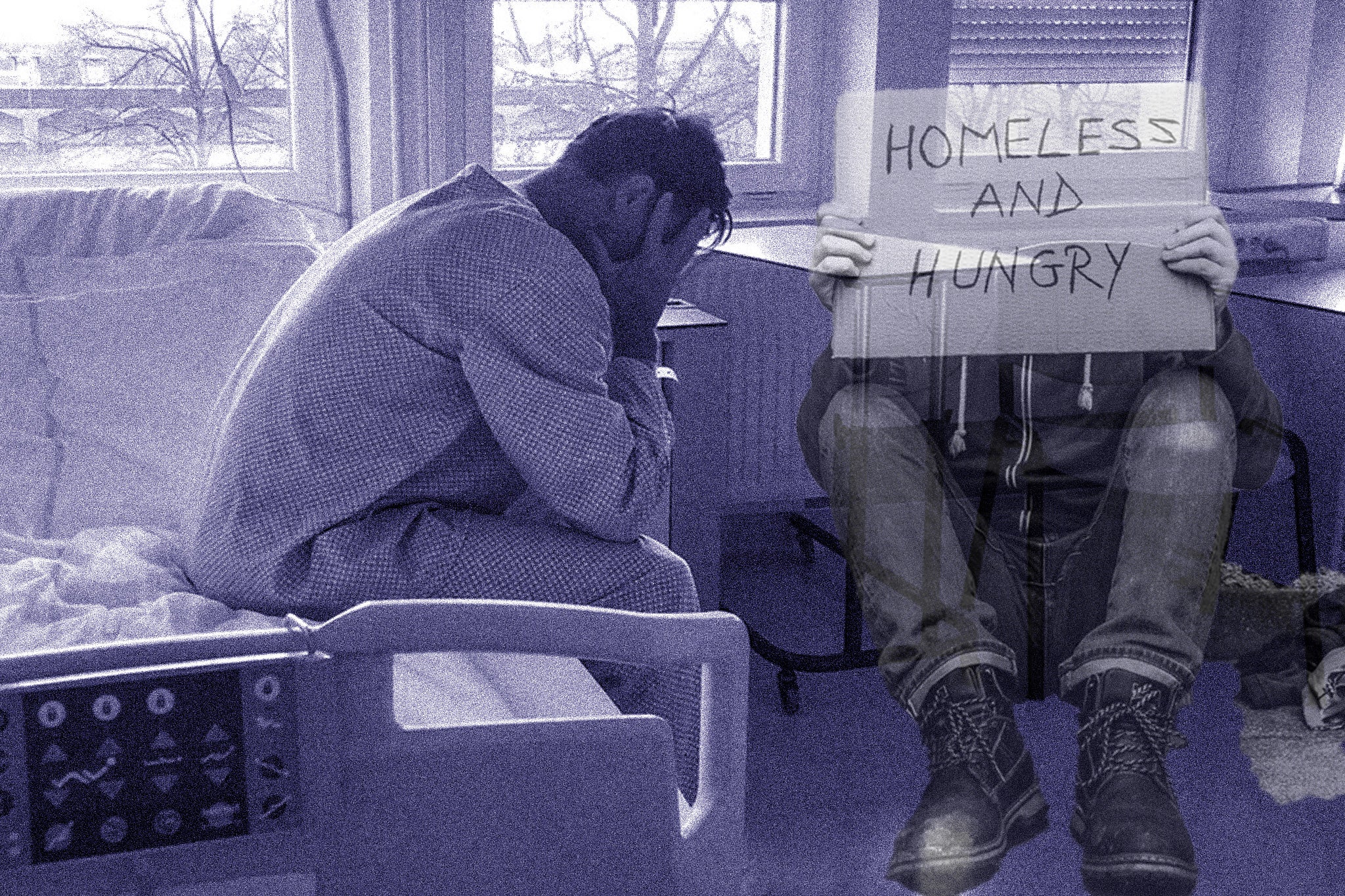
MPs have now called on the government to “break the link” between rough sleeping and discharge from public institutions – such as hospitals, prisons and asylum seeker hotels – as the figures give a harrowing snapshot into the homelessness crisis facing Britain.
Shadow homelessness minister Mike Amesbury warned those most in need are “falling through the cracks” as care and housing agencies were not working together.
‘It was the worst night of my life’ – Antonio
Antonio became homeless in the summer of 2023 after splitting up with his girlfriend and struggling to find a new place to live. With nowhere to stay, he gave up his job as a machine operator in a factory.
He soon became a regular at a homeless shelter run by the Salvation Army. It was the staff there who sent him to hospital when he told them he was experiencing swelling and pain in his testicle.
Before going in for his operation, Antonio had thrown his sleeping bag over a fence near the local Asda, where he had been sleeping rough for several months, to keep it safe.
He liked the spot because it was just far away enough from the city centre for him to be left in peace. He preferred to sleep alone, away from others who could steal his belongings or attack him – something he had experienced in the past.
However, after being discharged, Antonio was too ill to climb over the fence and retrieve his belongings. “It was the worst night of my life,” he tells The Independent.
Antonio decided to sit at the bus stop until he could find help in the morning. He was in considerable pain but didn’t want to take the drugs he had been given in case he fell into a deep sleep and could not keep himself safe.
“It was very, very hard, the pain. They gave me maybe 10 days’ worth of morphine but I knew I needed to be awake so I could get myself back to yhe Salvation Army the next morning,” he says. “God bless there was no rain, but it was not warm at all.”

He goes on: “If you fall asleep somewhere that people walk past you never know what will happen to you. I couldn’t get to the place where I used to sleep, where no one would see me, so I was just sitting there waiting. I survived till morning.”
Jillian Franks, project manager at the shelter, was able to step in when Antonio turned up the next day. She says she contacted the council’s social services team, who were able to help where the housing team wasn’t, and they found Antonio a B&B for two nights.
Antonio is now living in a care home and has gone through five rounds of chemotherapy. Caseworkers have helped him claim benefits and he is certain he won’t be going back to the streets.
Patients released after treatment for strokes, HIV and swelling on the brain
According to data uncovered by The Independent, of the 4,196 people discharged from hospital to no fixed abode in 2022/23, more than a quarter – 27 per cent – were readmitted as a patient within six months of their discharge.
Shockingly, the figure is likely to be much higher as only 98 of around 200 NHS trusts responded to requests for information. The figures are also likely to be an underestimate as, where trusts said the number of people was less than five, we counted that as just one patient.
Recording a patient as having no fixed abode acts as a good indicator of the number of homeless people being treated but it is not a perfect record. Some homeless people may give an old address, often out of shame, which means they won’t be recorded in the data. Likewise, some people might be recorded as no fixed abode if they came into hospital unconscious or in chaotic circumstances.
The data shows that:
- One person diagnosed with unspecified swelling in the brain or spinal cord was discharged from Sherwood Forest Hospitals NHS Foundation Trust to no fixed abode. The person, who also had substance abuse issues, was then readmitted less than six months later.
- At the Queen Elizabeth Hospital King’s Lynn NHS Foundation Trust, two individuals were discharged to no fixed abode from the maternity department.
- At Bedfordshire Hospitals NHS Trust, two people were discharged in the past year from the transient ischaemic attack service, which treats people who have had temporary or mild strokes.
- Four people with no recorded homes were also discharged from general surgery, which usually covers surgery on the abdominal organs among other things.
- At Chelsea and Westminster Hospital and West Middlesex University Hospital, 473 people were recorded as discharged to no fixed abode in 2022/23 – up from 341 in 2017/18 – mostly from general medicine, geriatric medicine and A&E. The trust said not everyone included as having no fixed abode would be homeless, and that all patients were discharged with appropriate care and support where possible.
- Twenty-three people were also discharged from these hospitals after treatment for problems with their stomach and intestines, which had been caused by HIV complications. Recent data shows Westminster has the largest rough sleeping population of any area in England.
The Independent approached every NHS trust named in the statistics. Further figures from local authorities for the same year show 2,910 homeless people were referred to councils from a hospital A&E, urgent treatment centre or in-patient care. A further 1,160 people were referred from mental health in-patient care.
According to recent research from the charity Homeless Link, 24 per cent of homeless people surveyed said they ended up on the streets after a recent hospital stay, with a further 21 per cent discharged into unsuitable accommodation.
Although the number of those discharged onto the street is down from its peak in 2017/18, MPs are calling on the government to pledge that no one will ever be discharged from hospitals onto the streets.
In a January letter sent to ministers across the government, coordinated by the All-Party Parliamentary Group for ending homelessness, 48 MPs said the government should “break the link between rough sleeping and discharge from a public institution”. They mentioned prisons and asylum accommodation, as well as hospitals, as releasing people onto the streets without help.

Responding to this investigation, a government spokesperson said “no one should be discharged from hospital to the streets”, adding that ministers were working “to make sure that people at risk of or experiencing homelessness have a place to stay”.
Mr Amesbury said the Tories were “forcing more and more vulnerable people onto the streets of Britain” and promised that a future Labour government would “deliver the biggest boost to affordable, social and council housing for a generation”.
An NHS England spokesperson says: “All patients experiencing or at risk of homelessness should be referred to a care transfer hub, with clinical teams identifying at-risk patients as early as possible.”
‘I was in hospital for seven months – when I came out I was homeless’ – Rosie
Rosie, whose name has been changed, ended up homeless after a serious injury from a fall landed her in hospital for seven months.
The 40-year-old had worked as a finance professional for a private medical clinic before her admission. She ended up staying in hospital far longer than expected after doctors discovered some pre-existing conditions.
Unable to keep up with the rent on her flat, Rosie had nowhere to live when she was discharged and ended up in a hotel for two months.
Discussions around her housing options started months before she finally had to leave, with a dedicated hospital discharge team working with the local council to try and find a suitable home for her as she was now reliant on a wheelchair.
Even with that support, the council struggled to find her a home and called in tech company Beam to help. Beam works to crowdfund money for people referred to them by councils and charities. They helped Rosie find a suitable rented property to live in, which was wheelchair accessible and near enough to the NHS trust that she goes to for care. Crucially, they convinced Rosie’s landlord to take her on as a tenant, despite her receiving benefits.
But, even then, Rosie had to spend two months in a hotel after being discharged before she could move into her more permanent home.
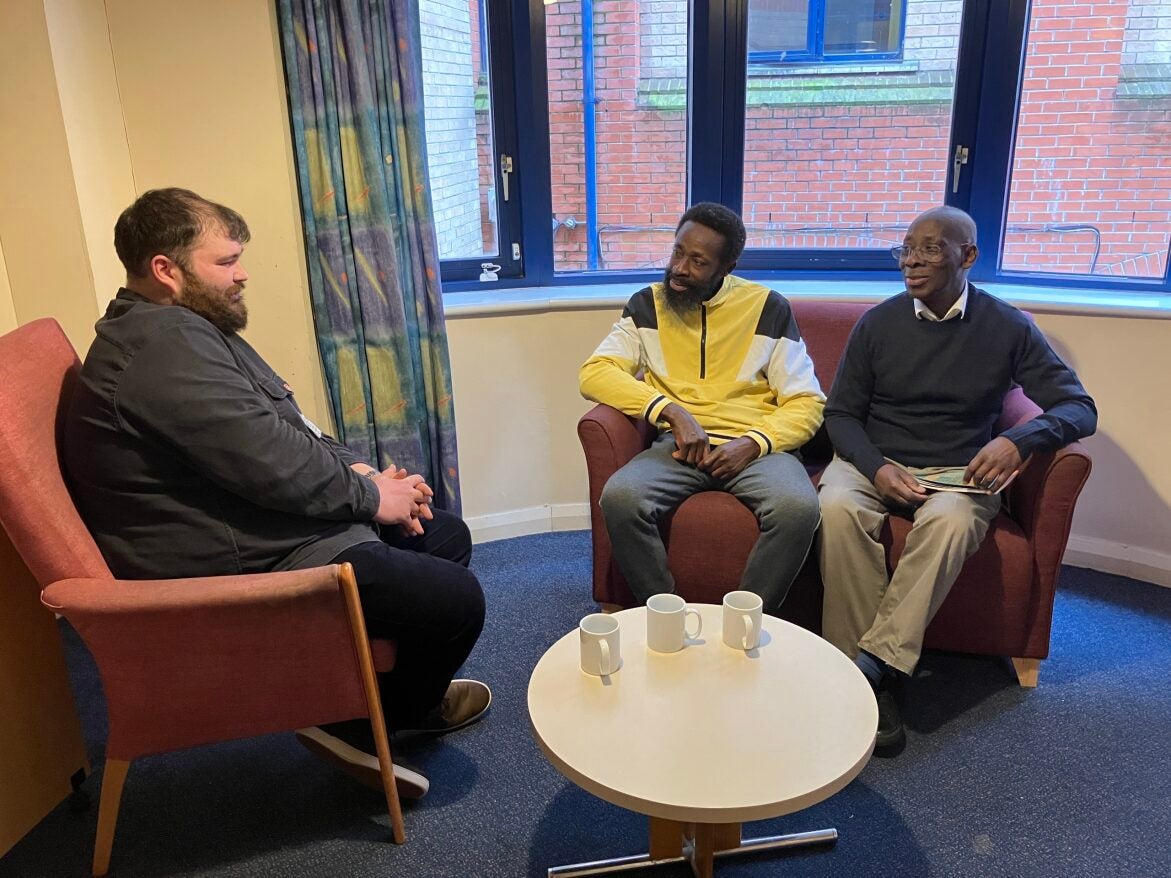
Alex Stephany, the founder of Beam, says: “There simply is not enough temporary accommodation or social housing around and so councils need to find ways of supporting people to enter the private rented sector where the vast majority of housing stock is.”
Priority given to pregnant women, the disabled and mentally unwell
With councils struggling to finance the ballooning costs of temporary accommodation, homeless people referred from hospital can often be turned away if they are not deemed to be in “priority need” for housing.
Housing laws state that councils have a duty to find accommodation for people who are homeless but only if they are classed as in priority need, such as pregnant women, a person with dependent children, someone with a disability, victims of abuse or those with severe mental illness.
To qualify as “vulnerable”, a person must be “significantly more vulnerable than an ordinary person would be if they became homeless”.
Sophie Boobis, at Homeless Link, says a lack of joined-up working between health teams and homelessness services was failing patients.
She says: “Essentially you have to be more vulnerable as a result of your illness, or more at risk of harm, compared to the average person experiencing homelessness.
“So the threshold for need can be quite high, especially as most people on the streets will be experiencing some sort of mental health difficulties and in many cases high levels of trauma.”
She adds that guidelines on homelessness health are not being consistently implemented across NHS trusts: “I think enforcement would really help, as would a greater understanding of homelessness within the health services.”
Nick Redmore, director of homeless services at the Salvation Army, says that, even if hospitals refer homeless patients to their local council, they will often be turned away, leaving hospitals with little choice but to discharge them back onto the streets.
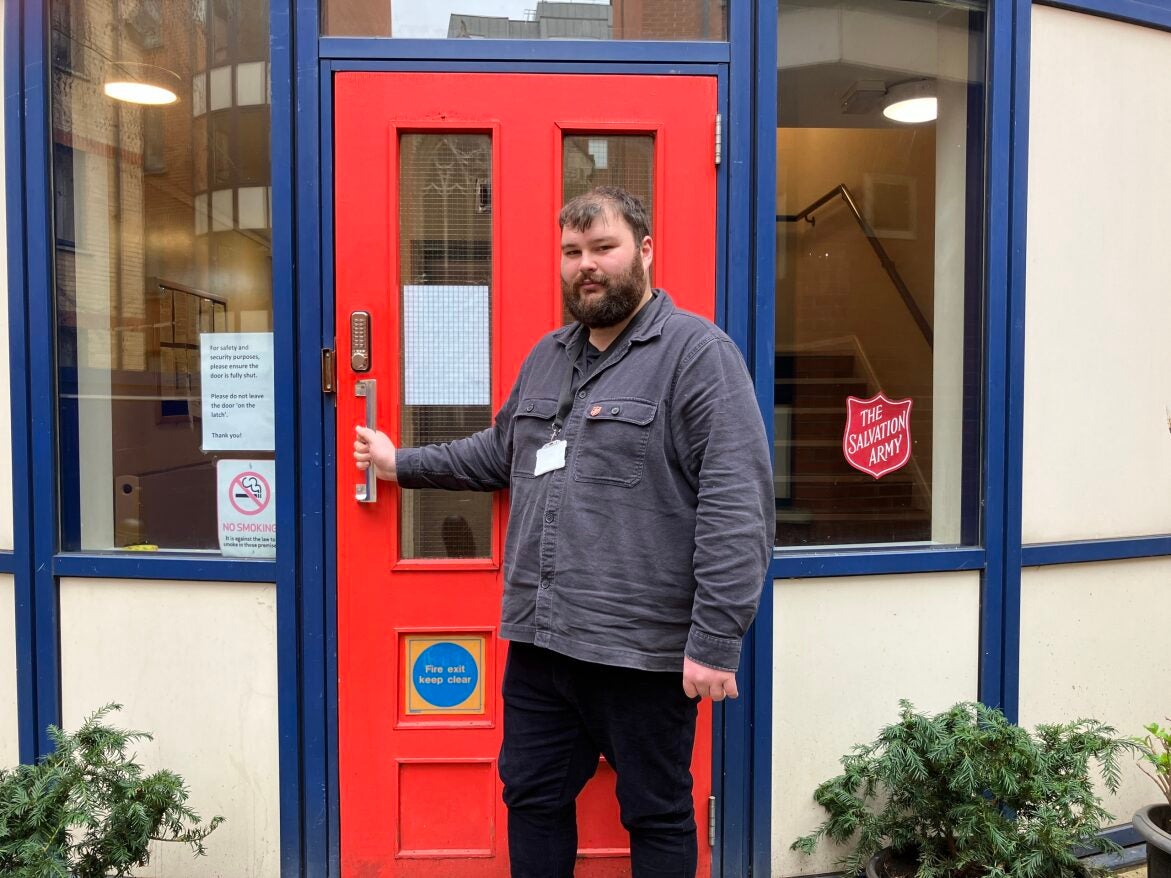
He says: “Forcing clinically vulnerable people to sleep rough can cause them undue pain and distress, reverse their recovery and be life-threatening. It also risks undoing the hard work of medical professionals and wasting NHS resources, as the high level of hospital readmittance shows.
“Despite the good intentions of hospital staff, these findings clearly show that the system is failing patients who are homeless. Living on the streets is no place for anyone let alone someone recovering from illness or surgery.”
Councillor Darren Rodwell, at the Local Government Association, says demand is outstripping supply for homes, adding: “Councils are under mounting pressure to find suitable homes for an ever-increasing number of people and are doing the best they can under the current circumstances.”
He adds that more support was needed to enable councils to build enough social homes for residents.
‘Some people come for help still wearing their hospital bands’ – Louis Juster
Some NHS trusts are trying to find a permanent solution. At St Ann’s shelter in Westminster, five rooms are available to house homeless people who are discharged from Guy’s and St Thomas’ hospital. The accommodation is funded by the NHS trust with support work provided by the Salvation Army.
Louis Juster, who works at the shelter, says the centre demonstrated what can happen if there is somewhere “to catch those people” who have been failed by other services.
One patient at St Ann’s had been living in a shed before he was admitted to hospital with various health complications, including heart failure, Mr Juster recounts. “He was not very well at all when he came here, to the point where he literally collapsed out in the courtyard out front. He was depressed for days on end sometimes, keeping to his room, and he had a couple of episodes of medication that were not quite right.
“Being here meant that he had people to talk to. It meant that when he did collapse, there were people around to call an ambulance and do first aid. I believe that on one of those occasions if he had still been in that shed, he would have just never woken up again. He would have died.”
According to research by the Museum of Homelessness, 1,313 people died while homeless in the UK in 2022.
Mr Juster also works at a homeless day centre near Oxford Circus, just two stops on the tube away from St Ann’s, yet the contrast is stark. “People come in relatively frequently – perhaps two or three times a year – with their hospital bands still on. They’ve been discharged perhaps a few days ago and they’ve already gone downhill to such a state that they need to go back in,” he explains.
Dennesse, the visiting nurse at St Ann’s, says patients come in with range of illnesses including fractures, leg ulcers, pneumonia, frost bite and diabetes. “There will be [illnesses] that are a direct result of rough sleeping and also things that are exacerbated by the rough sleeping,” she says. “One example of that is diabetes. There are also wounds from violence on on the streets.
“There was someone who was rough sleeping and someone stepped on them as a sort of power trip. One of his joints was hyperextended the wrong way.”
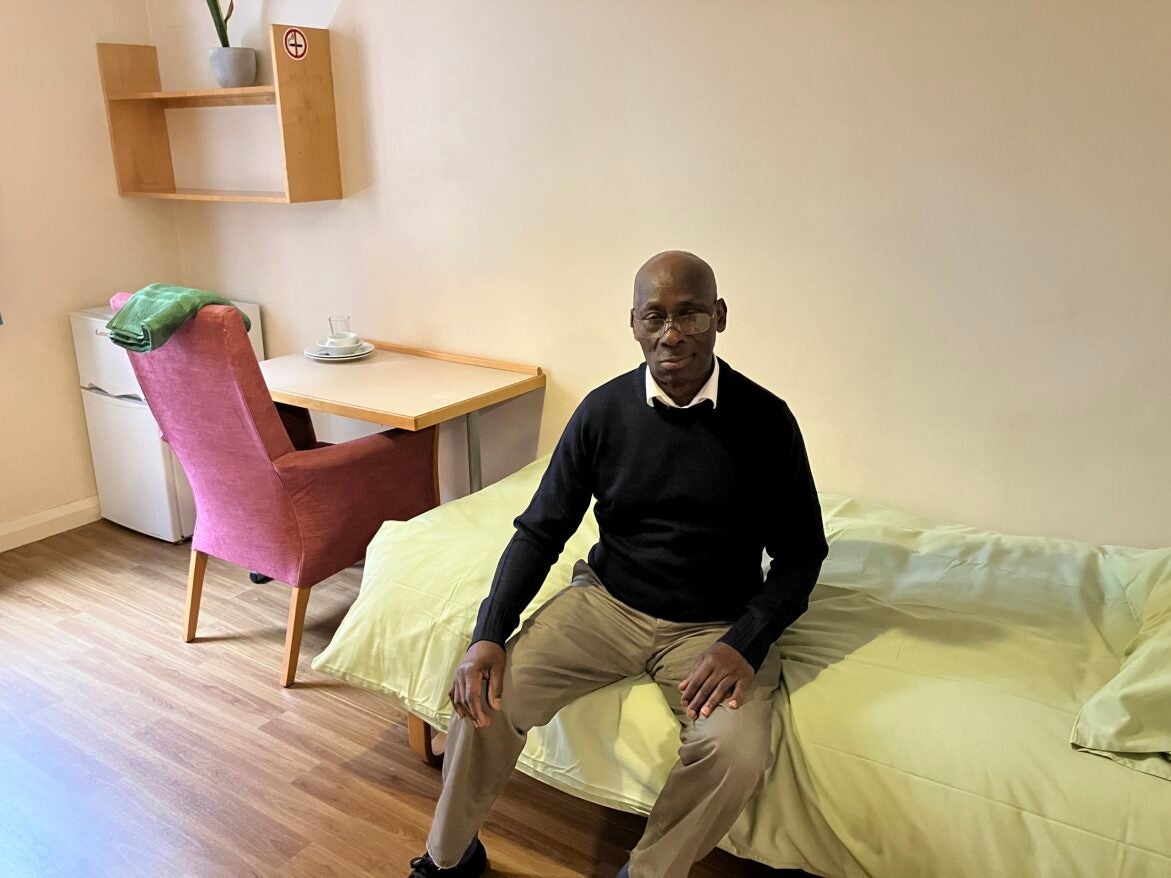
‘I was about to go back to the street – but then I was brought here’ – Charles, 68
Charles, 68, arrived at the centre in April 2023 after a four-week stay in hospital for untreated diabetes. Dressed smartly in a blazer and trousers given to him by the centre, he spoke to The Independent in St Ann’s lounge space – a small room with some sofas where residents relax and see the visiting nurse. The sitting room was near his bedroom, which he kept tidy – a wireless radio perched by his bed so he could sit and listen to the news.
Charles had been rough sleeping in London when he began to get sick – his legs and lower body swelling up, with wounds and sores developing on his legs. “I was able to see a nurse at a homelessness day centre and they did my blood pressure and it was over 200, very high. They said I needed to go to the hospital immediately. When they saw me [the A&E doctors] they said no you are not leaving,” he explains.
Charles’s diabetes had caused other complications including severe blurred vision caused by swelling behind his eye. He has since recovered his sight and when the time came for him to be discharged from hospital, Charles explained to the staff that he had nowhere to go and he had no belongings to take with him.
“They said, ‘There is a place, don’t worry’. They brought a cab and it brought me here. When I first came here I was so sick, I couldn’t do anything. I couldn’t even go to the kitchen to cook and one of the other men here, he cooked for me while I was not able to help myself.”
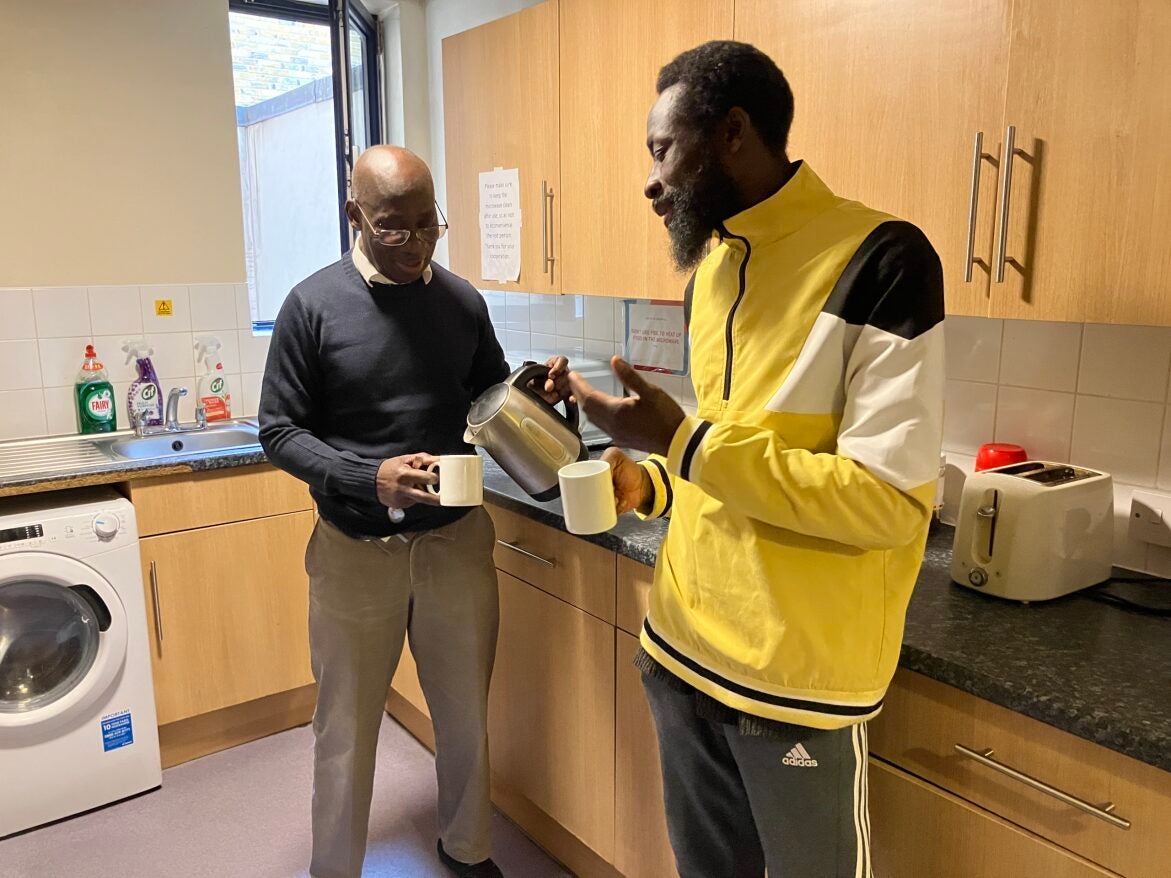
He adds sincerely: “These people, I will never turn my back against them, they helped me a lot”. Showing The Independent around the centre’s kitchen, he proudly opened a packed fridge full of vegetables, which he eats to keep healthy. He keeps his prized packet of pounded yam in his cupboard and sometimes cooks his native Ghanaian food for his fellow flatmates, he says.
He also has a care plan, printed out on a A4 piece of paper. A grid documented all the things his caseworkers are helping him with; obtaining a bus pass, registering for benefits, registering with a dentist, working to find future accommodation, among other things.
“They are able to do all these things for me,” he says, gesturing to the sheet. “I was going to die – my situation was so bad. I had wounds all over my body – because I was sleeping rough. But they were able to help me. I will never forget them, never.”
Join our commenting forum
Join thought-provoking conversations, follow other Independent readers and see their replies
Comments